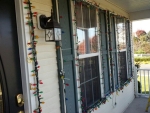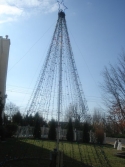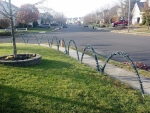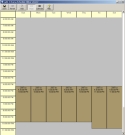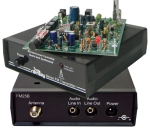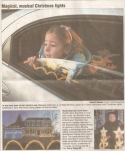How We Do It
Just how do we get all of the lights to blink, fade, twinkle and shimmer to the music? We get this question quite a lot.
Many people think we merely just connect the lights to a power supply and they automatically are synced with the music... we wish it were that easy.
Actually the system is made up of a series of controllers with each controller being assigned an ID number and a certain bank of
lights are connected into each of the controller's plugs with each one being 1 of the 16 channels encompassed in that unit.
All of our controllers are connected together via a data cable that is connected to a computer which is dedicated to run the show. The computer program we use (Light O Rama) contains a scheduling program that automatically starts the show at a designated time and ends it according to how we have programmed the scheduler to run. | ||
What I mentioned previously is the easy part. The hard part is the programming of each song to create what we call "sequences".
Once it is decided what songs we will use in our show they must be programmed first in the Light O Rama Software. So basically, I have to tell each
channel what to do at each part in the song. As an example, all of our windows have a strand of red lights, green lights and multi-colored lights on them.
Each one of those strands is dedicated to 1 channel each. First floor windows red = Channel 1, first floor windows green = Channel 2, first floor windows multi-color = Channel 3 and so on and so on.
The same is done for the roof gutters, bushes, trees and the railing lights.
| ||
Now for the time consuming part of the show (and no its not hanging all of the lights) By the way in case you were wondering we usually
start hanging our lights the day after Halloween. The real time consuming part is the programming of each song. Luckily this really only had to be done
when we first designed the show and only requires some minor editing if I decide something needs to be changed or if we decide to add more lights (Which by the way, we have done
every year since we started our show). The image above shows a sample of one of our sequences but not all of the channels are listed on there because it would
not fit in the screen shot. And actually that is only a 10 second segment of a song. On the left side is some of the channels and each box represents
1/10 of a second of music and I then program the software what I want each channel to do during each 10th of a second (fade up, fade down, shimmer, twinkle or set the light intensity from anywhere from 1% to 100% of power).
When we first designed our show the initial programming of the music took approximately 12 hours per song in order to get it just right.
| ||
In the above sequence picture you can also see a basic chase sequence that I programmed. The one pictured above is actually of our Mega Tree at the corner
of our property. With the above programming the tree lights will actually perform a spinning effect. By the way, our Mega Tree is actually a
20 foot telescoping flag pole with 4,800 red and green lights utilizing 16 channels.
Now, Once all of the programming is done and a decision is made on the lighting and types of lights used we then have to calculate
our power needs in order to assure we have an acceptable amount of outlets in order to handle the load being drawn by the lights.
Everyone always comments that our electrical bill must be through the roof but it really isn't too bad. Although they are expensive we have slowly
begun switching over to mostly LED lights due to the fact that they have a far less draw than the old fashion incandescent light bulbs.
Also, it is important to understand that the lights are not all always on for the entire show.... they are fading and blinking so we are never really at a
full draw on all the lights for more than a few seconds.
| ||
One of our favorite parts of our display are our leaping arches. We first created 4 of them in 2010
and doubled that number to 8 for our 2011 show. Each arch is made from a 10 foot piece of gray pvc separated into 7 segments each.
So basically each arch utilizes 7 channels and each channel is a strand of 100 count incandescent lights. This is the one area where I chose to
utilize incandescents as opposed to LED due to the fact that they look much better than the white LED lights but we still use energy efficient incandescents.
As mentioned previously each arch has 7 segments with each segment needing a dedicated channel so we would wrap one strand of lights around the pvc pipe covering
about 15" and then run its power cord across the pipe to the controller and then the next strand then the next until all 7 segments are done for each arch.
And no before you ask we DO NOT unwrap the lights from the arches but instead put them away just as they are. Each arch has 7 strands of 100 count lights which
comes to 700 lights per arch x 8 arches comes to 5,600 lights just for the arches themselves.
| ||
Once all of our songs are programmed we then create a show in the program by choosing which songs will play with their sequences that
we have programmed. After they are all entered into the show creator in the order we desire we save the file as a show. We then enter into the scheduling
editor portion of our software and tell the program what show we would like to play and when it should start and when it should end each night that we
have the light show running. The show builder also allows us to either have all of the songs play in a specific order or random. We choose to have ours in a
specific order so it is easier for visitors to know when they have heard all of the songs in our show.
| ||
Last but not least...getting the music outside for you to hear from the comfort and warmth of your car. We utilize a low powered
FM Transmitter which is dialed to a FM Frequency that is not in use locally by another radio station in order to assure a clear static free signal, in this case 91.5 FM.
The FM Transmitter is connected to the "audio out" jack of the computer running our show and allows you to hear the music while parked outside and up to approximately
2-3 blocks away. We also run an antennae line from the transmitter to the exterior of our house where we have an antennae mounted to provide a clear
signal for your listening enjoyment.
| ||
What you have just read is only a small part in the design and implimentation of a show of this size.
There are many other factors and things that must be done in order to get it up an running to the point that we are currently at but we do it mostly
because we enjoy it and it is a worthwhile cause as the donation bin gets filled up each night with food and money donations for the Burlington
County Food Pantry where we have aided in feeding numerous needy families through the holiday season.
| ||
OH and one final note. Not only do we do it as a good cause of raising money and food donations for the food pantry but there is also one
other important reason for "my madness". The look on a child's face as they are watching the show outside with their parents makes all of the work and time spent
a most rewarding hobby as you can see in the photo to the right that appeared in a local newspaper recently.
| ||
Latest News:
|
(100% of all proceeds go to the food pantry) |
|


